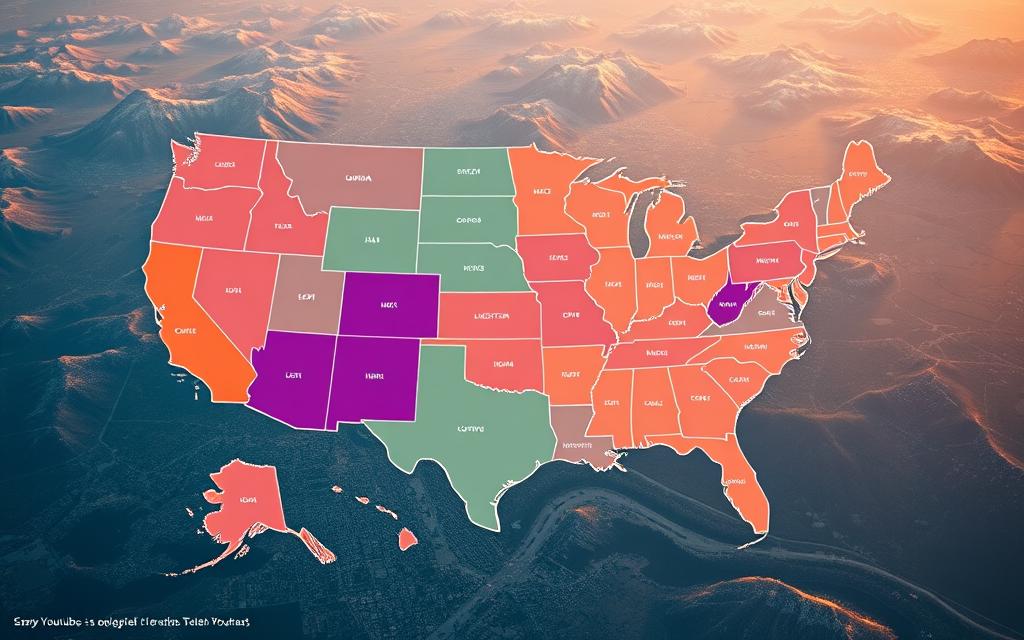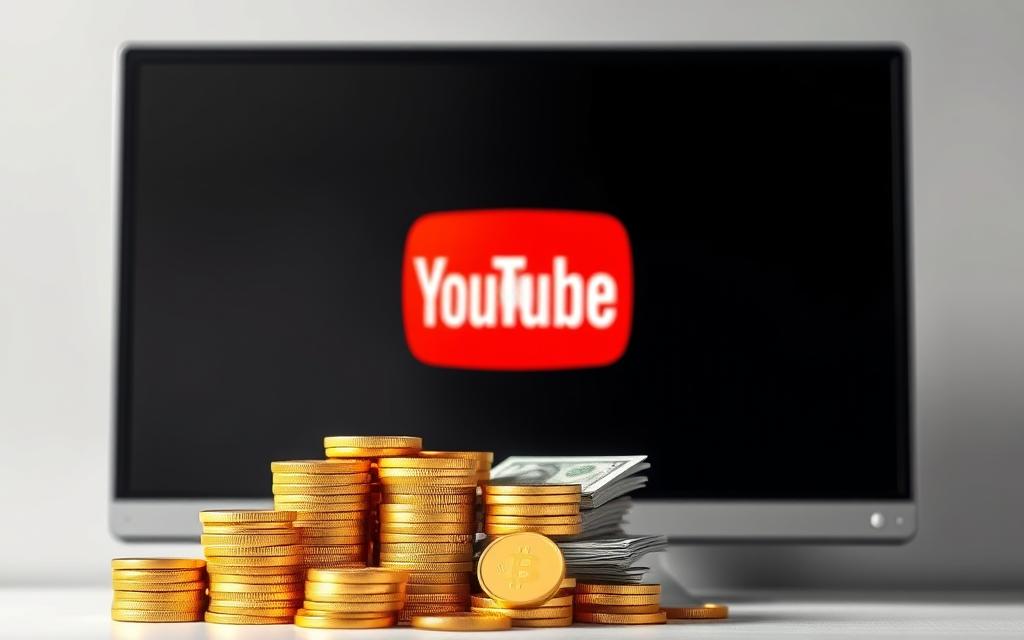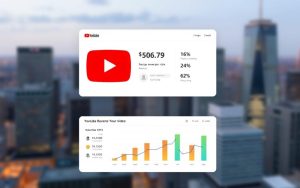Table of Contents
Creators often wonder about the financial potential of viral content. While numbers like 1 million views sound impressive, actual earnings vary widely. Factors like audience location, content niche, and engagement rates all play crucial roles.
Top creators like MrBeast generate millions monthly, while viral hits like Baby Shark demonstrate long-term earning power. However, most channels fall somewhere in between. YouTube takes a 45% cut of ad revenue, making diversification essential.
This guide breaks down key metrics like CPM and RPM. You’ll learn realistic earning ranges across different categories. We’ll also explore proven strategies to maximize income beyond ads.
Understanding YouTube’s Payment System
Monetizing content requires a clear grasp of how platforms distribute earnings. YouTube’s revenue-sharing model is built on ad placements, viewer engagement, and content type. The system rewards creators who understand key metrics and optimize their strategies.
How YouTube Monetization Works
The YouTube Partner Program unlocks earning potential. Once approved, creators earn 55% of ad revenue generated from their videos. YouTube retains the remaining 45% for platform maintenance and services.
Payments follow strict rules:
- Minimum $100 threshold before payout
- Monthly deposits via AdSense
- 21-day security hold on new channels
Premium subscribers contribute to creator revenue too. Their membership fees get distributed based on watch time. This adds to the overall earnings pool beyond traditional ads.
CPM vs RPM: Key Metrics Explained
Two critical numbers determine actual income:
| Metric | Definition | Creator Impact |
|---|---|---|
| CPM (Cost Per Mille) | Advertiser cost per 1,000 impressions | Indicates ad market value |
| RPM (Revenue Per Mille) | Creator earnings per 1,000 views | Actual take-home amount |
The formula connecting these metrics is simple:
RPM = (55% of CPM) × Monetized Play Rate
Case studies show average RPM between $2.20-$3.19. Gaming channels often fall on the lower end, while finance content commands premium rates. Viewer location also plays a major role – US audiences generate 3-5x more revenue than some international markets.
Smart creators track both numbers in Analytics. They optimize content to improve these values over time. Remember, not all views generate income. Ad blockers and non-monetized plays reduce measurable earnings.
Real Earnings from 1 Million YouTube Views
Earnings from viral videos vary dramatically across niches and creator strategies. While some creators earn thousands, others see modest returns due to RPM differences. Understanding these ranges helps set realistic expectations.
Breaking Down Niche-Specific Revenue
Finance content tops the charts with RPMs up to $29.30, while lifestyle niches average $1.61. This gap shows how advertiser demand shapes earnings. Below are real-world examples:
| Niche | RPM Range | Earnings per Million Views |
|---|---|---|
| Finance | $16.23–$29.30 | $16,230–$29,300 |
| Gaming | $2.00–$8.00 | $2,000–$8,000 |
| Education | $5.00–$15.00 | $5,000–$15,000 |
Case Studies: From Newcomers to Stars
Joseph Hogue’s finance channel earned $24,592 from 1.2 million video views, thanks to high-value ads. In contrast, Tatyana Savage’s lifestyle content generated $2.80 RPM—showcasing niche disparities.
Seasonal trends also matter. Q4 CPMs spike 20–30% due to holiday ads. Shorts fund payouts add another layer, averaging $0.75 per 49.7k views.
Earnings Formula: (Views × RPM) / 1000 = Total Revenue
Remember, not all views are monetized. Ad blockers and non-skippable ads affect final youtube pays amounts. Diversification remains key for stable income.
YouTube Partner Program Essentials
Gaining access to YouTube’s monetization tools starts with understanding program requirements. The YouTube Partner Program unlocks multiple revenue streams, but approval requires meeting specific benchmarks. Creators must choose between traditional long-form or Shorts-focused eligibility paths.
Eligibility Requirements
Two distinct paths exist for monetization access. Long-form creators need 1,000 subscribers plus 4,000 annual public watch hours. Shorts-focused channels require 10 million views on 90-day-old videos.
Additional requirements include:
- Active AdSense account linked to YouTube
- Two-step verification enabled
- No active community guideline strikes
- Channel compliance with all policies
The 30-day review process examines content quality and copyright standing. Some creators report approvals in days, while others wait months for manual verification.
Monetization Features Overview
Approved creators gain access to multiple income sources through the YouTube Partner Program. Each feature follows different revenue share models:
| Feature | Revenue Split | Requirements |
|---|---|---|
| Ad Revenue | 55% creator / 45% YouTube | Basic YPP approval |
| Channel Memberships | 70% creator / 30% YouTube | 30k+ subscribers |
| Super Chat & Stickers | 70% creator / 30% YouTube | Live streaming enabled |
Not all content qualifies for monetization. Reused material, controversial topics, and violent content may trigger manual reviews. Geographic restrictions also apply – the program remains unavailable in 31 countries as of 2024.
Channel memberships and Super Features require additional subscriber thresholds beyond basic YPP access. Smart creators plan content strategies around these milestones for maximum earning potential.
Top Earning Niches for YouTube Creators
Choosing the right content category significantly impacts earning potential. Some niches attract premium ad rates, while others thrive through volume or sponsorships. Understanding these differences helps creators maximize their revenue streams.

Educational Content: Highest CPMs
Channels like CrashCourse demonstrate the earning power of knowledge-sharing. With CPM rates between $5-$15, educational videos generate substantial income. Complex topics attract high-value advertisers seeking engaged audiences.
Key advantages include:
- Longer watch times from students
- Premium ad placements in tutorial content
- Multiple monetization avenues (courses, books)
Technology Reviews: Premium Ad Rates
Tech channels like Unbox Therapy benefit from lucrative product promotions. Brands pay top dollar to reach gadget enthusiasts. Typical earnings range from $4,000-$10,000 per million views.
| Tech Sub-Niche | Average RPM | Sponsorship Potential |
|---|---|---|
| Smartphone Reviews | $8.50 | Very High |
| Software Tutorials | $6.20 | Medium |
| Gadget Unboxings | $10.75 | Extreme |
Gaming Channels: Volume vs Value
While gaming content generates massive view counts, its CPM remains relatively low. Creators compensate through sponsorships and affiliate marketing. The key lies in building a loyal community.
Travel Vlogging: Sponsorship Potential
Destination videos attract tourism boards and travel brands. Though ad rates are moderate, partnership opportunities abound. Successful creators often earn more from sponsors than ads.
“Travel creators should focus on storytelling – brands pay for authentic experiences, not just scenery shots.”
Fitness & Health: Loyal Audience Value
Supplement companies aggressively target fitness channels. With revenue between $2,000-$8,000 per million views, this niche thrives on recurring sponsorships. The secret lies in demonstrating real results.
New creators should consider:
- Current market demand
- Personal expertise
- Long-term audience building
Key Factors That Determine Your Earnings
Your YouTube revenue isn’t just about view counts—several critical factors come into play. Geographic location, content format, and timing all influence what advertisers will pay. Understanding these variables helps creators optimize their strategies.
Viewer Demographics and Location
Where your viewers watch from dramatically affects earnings. US audiences generate $4.38 CPM on average, while Asian markets average $2.65. This means North American viewers often contribute 5x more revenue than Indian audiences per view.
Top-earning regions include:
- United States ($4.38 CPM)
- United Kingdom ($3.92 CPM)
- Canada ($3.85 CPM)
Content Length and Ad Placement
Videos over 8 minutes qualify for mid-roll ads, which can double revenue. The ideal structure places ads every 3-5 minutes to maintain retention. Video quality also matters—4K content often gets premium ad placements.
Best practices include:
- 15-minute videos for 2-3 mid-roll slots
- Natural breaks for ad insertion
- Higher production values for better rates
Seasonal Advertising Trends
Q4 holiday ads boost CPM by 20-30% across all niches. Back-to-school periods also see spikes in education-related content rates. Smart creators plan content calendars around these fluctuations.
“November through December delivers 40% of many creators’ annual ad revenue.”
Mobile vs desktop viewing also impacts earnings. Desktop video plays often generate higher CPMs due to larger ad displays. These factors combined create the complex equation behind every creator’s paycheck.
Ad Types and Their Revenue Impact
The type of ads you enable directly influences your YouTube paycheck. Different formats generate varying revenue based on viewer interaction and advertiser demand. Optimizing your ad mix requires understanding these key differences.
Skippable vs Non-skippable Ads
Skippable ads (after 5 seconds) offer flexibility but lower CPM. Non-skippable 15-second spots command premium rates but risk viewer drop-off. The right balance depends on your content length and audience tolerance.
| Ad Type | Duration | Average CPM | Completion Rate |
|---|---|---|---|
| Non-skippable | 15 seconds | $8.40 | 92% |
| Skippable | 5-30 seconds | $4.75 | 68% |
Mid-roll placements work best in videos over 8 minutes. However, excessive ads hurt retention. YouTube recommends:
- 1 pre-roll per video
- Mid-roll every 3-5 minutes
- Maximum 3 ads per 10-minute content
Bumper Ads and Shorts Monetization
6-second bumper ads deliver high completion rates with moderate revenue. These unskippable spots work well for brand awareness campaigns. For Shorts, the YouTube Partner Program offers:
$0.75 per 49.7k views from the Shorts Fund (2024 data)
Effective bumper ads follow these creative rules:
- Lead with strongest visual in first frame
- Include branding within 2 seconds
- Use clear call-to-action
Premium members contribute additional view-based earnings. Their watch time gets calculated into your overall revenue share. Diversifying across ad types typically yields 18-22% higher income than single-format strategies.
Beyond Ad Revenue: Diversifying Income
Successful creators know ads alone won’t build sustainable income. The most profitable channels combine multiple revenue streams, from exclusive content to physical products. This approach cushions against algorithm changes and ad rate fluctuations.
Channel Memberships and Super Features
Channel memberships offer fans exclusive perks for monthly fees. YouTube takes just 30% compared to 45% from ads. Popular tiers range from $4.99 for basic access to $99.99 for VIP experiences.
Live streams unlock additional money through Super Chats and Stickers. Top creators report $100-$500 per stream from viewer donations. These features work best when:
- Streams follow consistent schedules
- Interactive elements engage the audience
- Exclusive content rewards top supporters
Brand Partnerships and Sponsorships
Brand deals often surpass ad revenue for mid-sized channels. Rates typically follow CPM models, with $10-$50 per thousand views being standard. Dude Perfect’s $100M empire proves the potential of strategic partnerships.
“Always disclose sponsorships clearly – FTC fines can erase months of earnings overnight.”
Affiliate marketing complements sponsorships, with 1-5% conversion rates being typical. Electronics and software tutorials perform particularly well with this model.
Merchandising Opportunities
Physical products generate 40-60% margins when sold directly. MrBeast Burger demonstrates how virtual brands can scale, earning $500k monthly. Digital products like presets and courses require no inventory but deliver recurring income.
Key considerations for merch success:
- Designs reflecting channel identity
- Limited-edition drops for urgency
- Bundles with channel memberships
Live events complete the ecosystem, with meetups and conventions creating both revenue and content opportunities. The most successful creators treat each video as a gateway to these diversified money streams.
Optimizing Your Content for Maximum Revenue
Strategic video formatting directly impacts revenue potential. The right combination of length, structure, and discoverability transforms views into sustainable income. Top creators treat each upload as a revenue-generating asset.

Video Length Strategies
Eight minutes marks the threshold for mid-roll ads, but 15-minute videos perform best for ad density. This sweet spot balances viewer retention with monetization opportunities. Retention graphs reveal where to trim dead zones.
Effective ad placement follows these rules:
- One pre-roll per video
- Mid-roll breaks every 3-5 minutes
- Maximum three ads in 10-minute content
Evergreen content maintains value longer than trending pieces. However, seasonal topics can spike CPM during high-ad-demand periods. The most successful channels blend both approaches.
SEO Best Practices for Higher CPM
Tools like VidIQ and TubeBuddy help identify high-value keywords. Title tag stacking (“How to __ That __”) improves search visibility without appearing spammy. Transcript optimization makes content indexable.
Thumbnail A/B testing impacts CTR significantly. Playlists boost watch time and CPM by keeping viewers engaged. End screens effectively promote merchandise without disrupting flow.
“Chapters increase retention by 12% on average – YouTube’s algorithm rewards this structure.”
Avoid clickbait that harms long-term RPM. Instead, deliver promised value while strategically placing monetization elements. This balance sustains audience trust and revenue growth.
The Role of Audience Engagement
Building a thriving channel goes beyond uploads—it’s about fostering genuine connections. Engaged audiences drive higher watch time, better ad performance, and increased algorithm favorability. Channels with 4.9%+ engagement rates typically see 73% more recurring views from loyal subscribers.
Watch Time vs Click-Through Rates
These two metrics work together to boost visibility:
- Watch time signals content quality to YouTube’s algorithm
- High CTR (above 5%) improves search rankings
- Balanced performance in both areas maximizes reach
Calculate engagement rate with this formula:
(Likes + Comments + Shares) / Total Views × 100
Building Loyal Subscriber Bases
Turn casual viewers into dedicated fans with these tactics:
- Enable notification bells (top channels convert 18% of visitors)
- Use Community tabs for behind-the-scenes content
- Create poll cards to boost interaction
Like Nastya’s 96B-view empire proves the power of loyal audiences. Her team focuses on:
| Strategy | Impact |
|---|---|
| Consistent upload schedule | +42% retention |
| Interactive elements | 3.8x more shares |
Avoid artificial growth tactics—YouTube penalizes channels using sub bots. Instead, offer genuine value through:
- Exclusive member-only live streams
- Early video access for subscribers
- Personalized shoutouts
Prime posting times vary by niche. Family content peaks at 4-6 PM weekdays, while gaming videos perform best at 8-10 PM weekends. Test different slots to find your sweet spot.
Geographic Considerations for US Creators
The geographic origin of your viewers significantly impacts revenue potential. US creators often see 3x higher CPMs than global averages, making location analysis essential. Strategic targeting and content adaptation can unlock hidden earning opportunities.

Domestic vs International Audience Value
Not all views generate equal revenue. US audiences deliver premium value, while emerging markets grow rapidly but pay less. Compare these RPM averages:
| Country | Average RPM | CPM Multiplier |
|---|---|---|
| United States | $8.40 | 3.0x |
| United Kingdom | $5.75 | 2.1x |
| India | $1.90 | 0.7x |
Language overlays affect earnings too. English content typically earns 22% more than localized versions. However, complete translations can boost watch time by 40%.
Localization Strategies
Effective geo-targeting requires more than subtitles. AIR Media-Tech increased revenue 58% by implementing this checklist:
- Time zone optimization for premieres (8 PM local)
- Cultural adaptation of thumbnails
- Geo-filtered analytics reviews
- CC/subtitle quality checks
“Our localized gaming content saw 73% retention boosts in Brazil and Mexico markets.” – AIR Media-Tech case study
Avoid artificial geo-targeting with VPNs. YouTube’s systems detect these patterns and may restrict monetization. Instead, focus on organic marketing in high-value regions.
Emerging markets like Indonesia and Nigeria show promising CPM growth. Early adopters who build audience trust now will benefit from future rate increases.
Common Monetization Mistakes to Avoid
Many creators unintentionally sabotage their earning potential through avoidable errors. These missteps range from poor ad placement to copyright missteps that can derail entire channels. Recognizing these pitfalls early helps maintain steady revenue growth.
Ad Overload Pitfalls
Excessive ads drive viewers away faster than they generate income. Studies show videos with 3+ mid-roll ads in 15 minutes suffer 42% retention drops. The sweet spot balances earnings with viewer experience.
Follow these ad placement best practices:
- 15-minute videos: 2 mid-roll maximum
- Natural breaks for ad insertion
- Monitor retention graphs for dead zones
Heatmap analysis reveals ideal placement points. Avoid clustering ads near the beginning or end. Spread them evenly throughout engaging segments.
Content ID Claims Issues
Copyright problems tank 62% of rejected YouTube Partner Program applications. The platform’s automated systems flag reused content aggressively. Even accidental violations carry severe penalties.
Understand these critical guidelines:
- Transformative edits must add substantial value
- Music pitch/speed changes don’t qualify as original
- Compilations require commentary throughout
“Manual claims resolve faster than automated blocks—respond within 72 hours with proper documentation.”
For disputed claims:
- File counter-notification immediately
- Provide evidence of fair use
- Consider audio swapping alternatives
Creative Commons hubs like Jamendo offer safe audio options. Regular audits of YouTube Studio reports prevent surprises. YouTube’s monetization requirements clearly outline prohibited formats.
Successful appeals require patience. The average resolution takes 14-21 days. During disputes, focus on creating new, fully original content to maintain channel momentum.
Tools to Track and Improve Earnings
Data-driven creators leverage specialized tools to maximize their channel’s financial performance. Understanding traffic sources, ad performance, and audience behavior separates thriving channels from stagnant ones. The right analytics approach can reveal hidden revenue opportunities in your existing content.

YouTube Analytics Deep Dive
YouTube Studio provides foundational metrics, but advanced creators need deeper insights. Focus on these key areas in your analytics dashboard:
| Metric Group | Revenue Impact | Optimization Tip |
|---|---|---|
| Traffic Sources | Identifies highest-earning platforms | Double down on top referrers |
| Audience Retention | Shows monetizable watch time | Trim content at drop-off points |
| Revenue by Video | Reveals top-performing content | Create similar high-RPM videos |
Custom dashboards help track what matters most. Set up separate views for:
- Ad performance by format (pre-roll vs mid-roll)
- Geographic revenue distribution
- Device-specific earnings (mobile vs desktop)
Third-Party Revenue Boosters
Specialized platforms enhance YouTube’s native analytics. TubeBuddy’s A/B testing features improve CTR by up to 22%, while VidIQ’s keyword tools uncover high-value content opportunities.
“AIR Media-Tech’s Ads Revenue Boost service helped partners achieve 125B views through programmatic ad optimization and placement strategies.”
Essential third-party solutions include:
- Social Blade for growth projections
- Spring for seamless merch integration
- FameBit for sponsorship matching
Warning: Avoid services promising artificial growth. YouTube’s algorithms detect fake engagement and may demonetize channels. Instead, focus on legitimate tools that provide transparent data analysis.
For financial tracking, consider QuickBooks or Wave for creator-specific tax reporting. These platforms automatically categorize YouTube earnings and deductible expenses.
Future Trends in YouTube Monetization
The digital content landscape evolves rapidly, demanding creators stay ahead of monetization shifts. Platform innovations and changing viewer habits create both challenges and opportunities. Understanding these developments helps channels future-proof their revenue streams.
Shorts Monetization Reaches New Heights
YouTube’s $100M Shorts Fund signals serious commitment to short-form video. Early data suggests vertical content will achieve RPM parity with long-form by 2025. Three key developments drive this shift:
- Vertical video ad formats doubling CPMs since 2023
- 60-second limit expansion enabling better storytelling
- Improved creator tools for shoppable Shorts
“Shorts now deliver 58% of all new channel subscriptions – the format’s monetization potential can’t be ignored.”
| Feature | 2023 Status | 2025 Projection |
|---|---|---|
| Shorts RPM | $0.75 | $3.20 |
| Ad Formats | 2 types | 7+ interactive options |
Next-Generation Content Opportunities
AI-generated videos face stricter monetization policies but offer efficiency gains. YouTube’s updated guidelines require:
- Clear AI disclosure in descriptions
- Substantial human editing for approval
- Original assets for commercial use
VR and AR content enters beta testing with spatial ad placements. Early adopters report 40% higher engagement in immersive formats. Podcast video crossovers also gain traction, with 72% of top shows now publishing visual versions.
Emerging models like gated memberships and NFT perks show promise. However, deepfake restrictions require careful navigation. Creators should:
- Audit tools for compliance
- Disclose synthetic media clearly
- Maintain original content balance
The TikTok vs YouTube Shorts battle intensifies, but smart creators leverage both. Multi-platform strategies now yield 22% higher revenue than single-source approaches.
Conclusion: Maximizing Your YouTube Revenue Potential
Successful creators treat their channels as businesses, not just content hubs. The RPM formula (55% CPM × monetization rate) provides the foundation, but niche selection determines earning ceilings.
Diversification separates sustainable revenue from temporary spikes. Combine ads with sponsorships, memberships, and digital products. Analytics reveal which content delivers real value to both viewers and advertisers.
Localization and engagement transform views into loyal fans. Avoid policy mistakes that jeopardize money-making privileges. The platform constantly evolves—stay adaptable.
Top performers prove consistent effort yields results. Audit your channel today using these principles. Small optimizations compound into significant earnings over time.
FAQ
What is the average earnings range for 1 million YouTube views?
Earnings vary widely, but most creators make between ,000 and ,000 per million views. Factors like niche, audience location, and ad engagement influence payouts.
How does YouTube monetization work?
Creators earn through ads, memberships, and sponsorships. The YouTube Partner Program shares ad revenue based on impressions, viewer demographics, and content type.
What’s the difference between CPM and RPM?
CPM (cost per mille) measures ad revenue per 1,000 impressions. RPM (revenue per mille) reflects total earnings per 1,000 views after YouTube’s cut.
Which niches have the highest CPM rates?
Finance, tech reviews, and education often yield premium CPMs. Advertisers pay more for engaged audiences in competitive markets.
How do viewer locations impact earnings?
Views from the U.S., Canada, and Europe generate higher revenue due to stronger ad markets. Emerging regions typically pay less per view.
Can you monetize YouTube Shorts?
Yes, but revenue differs from long-form content. Shorts use a separate monetization pool based on music licensing and creator fund allocations.
What are common mistakes that hurt earnings?
Overloading videos with ads risks viewer drop-off. Ignoring analytics or violating content guidelines can also limit monetization potential.
How important is audience engagement for revenue?
High watch time and retention boost ad performance. Loyal subscribers and repeat viewers increase RPM by improving content discoverability.
Are brand sponsorships more profitable than ads?
Often, yes. Direct deals with companies can pay significantly more than ad revenue, especially for creators with niche authority.
What tools help track YouTube earnings?
YouTube Studio provides detailed analytics. Third-party tools like TubeBuddy or VidIQ optimize SEO and suggest revenue-boosting strategies.









